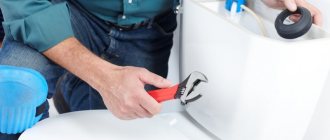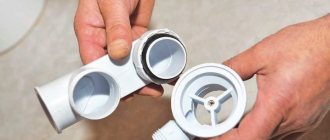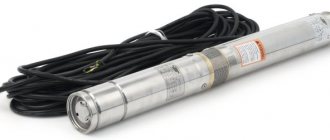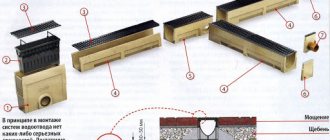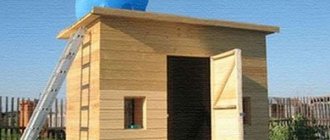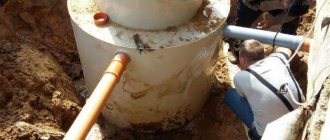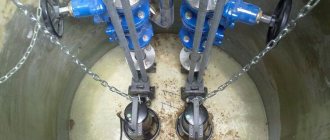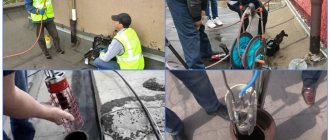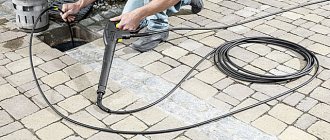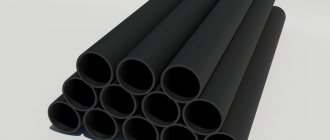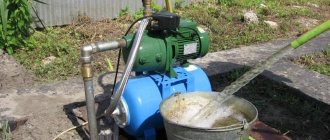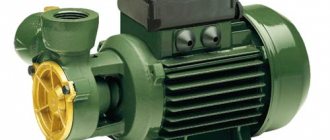To remove waste liquid, a gravity sewer is installed. In areas where there is no possibility of organizing a gravity system, forced movement of water is created using a sewer pump.
A submersible pump is used to pump waste out of cesspools and drainage wells, and surface plumbing models work directly after flushing waste into the toilet.
Device and purpose
Sewage pumps consist of a small volume container and a built-in motor that moves wastewater. Liquid moves horizontally and vertically. The equipment can be with or without a cutting element.
Application area
The device is often used when plumbing fixtures are installed below the drain hole. For this purpose, special pumps have been developed, thanks to which bathrooms can be moved to the basement. The device is suitable for installation after repair work and in cases where the system is not connected to the installation site of plumbing equipment. In such a situation, the plumbing fixtures are connected to a small pump, and the pump is connected to the drain.
Installing the device at home differs from installing a gravity sewer:
- pipes can be routed horizontally up to 100 m with a slope of at least 1-4%;
- pipeline diameter is 28-40 mm;
- The drain can be raised up to 9 m.
On the left is a diagram of the operation of a submersible pump, on the right is the general structure of a plumbing pump for sewerage.
Design and principle of operation
The components of the device are a container and a motor. Some options are equipped with a grinder and are used for the toilet. To monitor the filling level, a special sensor is installed in the device. The waste flows into the sewer after it is turned on. Then the pump and chopper are connected. The device turns off after a signal from another sensor when the wastewater falls below the set level. This is how pressure sewer works.
A different number of different devices can be connected to pumping stations. Some are connected to 1-2 devices, and the most productive include stations with a main and 3 additional pipes. The container may have several inlets and one outlet.
Inputs are used to connect plumbing fixtures, and the outlet is mounted to the drain. Models made of heat-resistant materials are suitable for high-temperature waste liquid. They are able to cope with high temperature loads.
Scope of application of fecal pumps
The scope of application of these devices is wide. The device is considered universal and is used both in dachas, private homes, and in agriculture, factories and various buildings. They are used for:
- regulation and installation of the optimal water level in storm sewers;
- sewerage system devices;
- pumping out liquid from a flooded room, cesspools, and also the basement after rainfall;
- pumping out fecal matter;
- pumping out manure on farms;
- drying reservoirs, rivers, lakes.
In different situations, a certain type of sewage pump is chosen. To dry reservoirs, choose the most powerful fecal device with a large diameter. For storm sewers, the choice is a simpler option - with a yellow float to regulate the liquid level. When the water reaches a critical level, the automatic engine starts and drains the liquid.
Advantages and disadvantages
The main advantage of the compact device is the possibility of arranging sewerage as part of repairs after construction and installation with a low location of plumbing equipment (below the drain hole). When installing powerful pumps, the pipe diameter is 50 mm. Such a plumbing network can be easily disguised. If you cannot hide it, then it does not stand out as much as an installation made from a pipeline with a diameter of 100 mm.
A sanitary pumping station can be installed both in the kitchen and in the bathroom.
The pumps have the following disadvantages:
- Device noise. Some companies are improving their models, but the noise does not go away.
- Burnout of devices. The device can work for several years if it was chosen correctly and large objects do not fall into the sewer. If the choice of model was incorrect and the device works at its maximum, then it breaks down. The toilet pump must have high power.
- Electricity requirement. When there is no power, the drain does not function. To ensure uninterrupted operation, a backup source is required.
- Correct operation. Fibrous materials and hair should not get into the cutting element, which wrap around the screw and reduce the quality of grinding. After some time, the screw will stop working normally. The equipment will not burn out, since the overheating sensor will work, but the installation will need to be disassembled and cleaned.
Purpose: drainage or fecal
The degree of wastewater contamination determines the type of pumping equipment used to remove the liquid away from the home. If the main purpose of purchasing a pump is to pump out water from a washing machine or dishwasher, then it is quite enough to purchase a drainage pump.
In this case, the size of wastewater fractions should not exceed 50 mm, otherwise a blockage will form and the equipment may simply fail. It is for this reason that a fecal pump should be used to remove feces, as well as contaminated water, which contains large fractions ranging in size from 50 to 100 mm.
The capabilities of such equipment are quite sufficient to move biomass through pipes without creating blockages. For this purpose, the design provides for enlarged flow channels. To increase operating efficiency, models with a chopper have been created. This unit will be able to crush large solid fractions for successful passage through pipes. The name of this technique is fecal aggregates.
Types of pumps for pressure sewerage
Forced sewerage devices differ from water-lifting ones. The latter are suitable for clean water. If feces and large particles penetrate, the device breaks down.
Sewage pumps are used for pumping out:
- silt from various pits;
- dirty water from basements;
- liquids from sewer networks;
- silty sediment from a well.
The drainage system does not pump out wastewater.
Submersible devices
This type of equipment is lowered completely into the sewer. The design consists of stainless steel parts that will not break when interacting with wastewater. The submersible device is installed in the container or suspended above it. The pump runs automatically. When the space is filled with waste, the float rises and the pumping of contaminated water starts.
When the container is empty, the device turns off. Models are equipped with shredders. This mechanism crushes large particles that can damage equipment.
Most often, equipment equipped with a grinder is used as a submersible pump.
Surface Models
The devices are mounted near a collector, where waste liquid accumulates and is redirected, or a manhole. Installation is usually called dry. A hose is connected to the pump, lowered into a container and the wastewater is pumped out.
When choosing a model, pay attention to the suction depth indicated by the manufacturer. It is 8-10 m. If the depth is greater, the mechanism will not lift the liquid. The surface version is easily dismantled and washed. A low-power model is installed near a storage tank. Powerful equipment is mounted on a prepared area and secured to the floor.
When installing a submersible pump, it must be protected from moisture. If water gets under the housing, a short circuit will occur. The device is suitable for basements and heated utility rooms. If the equipment is to be used periodically, it is recommended to select a submersible device.
Semi-submersible units
The model has an electric motor installed above the water and a working chamber immersed in the liquid. A shaft rotates between these elements. The semi-submersible device is mounted on the tank wall or platform near the tank.
The device does not have a grinding mechanism. It is installed additionally, which increases the cost of the equipment and complicates operation. Such installations are most often used in industrial production.
Small units for drainage from plumbing fixtures
Plumbing pumps do not take up much space and can fit under most toilet models.
A small device that is installed near plumbing fixtures, suitable for toilets and sinks. The liquid enters the container and is then pumped out into the system. The device resembles a pump and is installed in different areas.
It will be able to pump wastewater from the tank into the sewer even with the outlet directed upward. Toilet pumps have a cutting part that crushes large particles. To avoid the appearance of unpleasant odors in the apartment, a filter is installed in the design.
General description and components of sewage pumps
Sewage pumps are designed to pump out not only contaminated water, but also drain basements, swimming pools and cesspools. There are 3 types of these structures:
- Drainage
2. Fecal.
3. Sewage pumping stations.
Drainage pumps only clean water with a low level of contamination. Fecal pumps are capable of pumping out liquid from sewage with a high level of pollution. Sewage stations “discharge” wastewater.
In general terms, sewerage devices are immersed underground for the purpose of pumping liquids of a certain degree of contamination. Usually in special stores you can find pumps made of stainless steel, cast iron and plastic. There is a level sensor that controls the automatic activation of the pump.
The float switch is the automatic pump switch. When fecal matter accumulates at a certain level, the switch closes or opens. It can be adjusted to different levels of pumping contaminated water.
The float switch consists of an air box. The container is made of plastic material. There is also a metal ball located inside. Using electrical contacts, the key is turned on when the mass level reaches its maximum. If the amount of liquid decreases, the “float” turns off - the contacts open and the engine turns off.
Sewage pumps are new. You don't need to enable them yourself. But these devices have two differences: the shape and type of impeller.
An impeller is an impeller that pumps liquid. There are several types of impeller:
- multi-channel closed type - distills clean water without various impurities and debris;
- multi-channel semi-closed type - the permissible level of contamination is slightly below average;
- VORTEX - the device pumps out heavily contaminated masses;
- impeller with one channel - medium-hard masses;
- impeller with two channels – masses containing a large amount of solid fecal matter;
- wheel with a knife - crushes all waste that ends up in wastewater.
Another difference between sewage pumps is the diameter. Drainage pumps that pump exclusively clean water have a maximum diameter of 10 mm. Pumping stations working with solid fecal matter and garbage in the form of toilet paper and other things - up to 100 mm.
How to choose pumping equipment
To choose a pump, you need to take into account its characteristics.
Maximum head and lift height
The distance over which the pump lifts the wastewater depends on the pressure indicator. It must be taken into account that there are vertically and horizontally located pipe sections. To calculate the parameter, the horizontal distance indicator is divided by 10 and added to the vertical footage from the edge of the container to the pump. The result should be 20-25% less than what is indicated in the documents for the equipment.
You should also consider:
- pipe diameter;
- speed of fluid movement;
- temperature and components of sewage waste;
- pressure;
- pipeline material and other factors.
If you do not have knowledge in the field of arranging a sewer system, then you can get advice from a specialist or purchase a device with a reserve of power and pressure so that it works for a long time.
Working temperature
The equipment is divided into the following groups:
- for hot water (up to +90°C);
- for cold wastewater (up to +45°C).
When only cold liquid enters the sewer, the second option is suitable. The device is most often installed in country houses. Boiling liquid enters the sewer during an emergency discharge from the heating system.
Submersible pump housings are made of both plastic and stainless steel.
Availability of automation
It is difficult to operate a sewage pump manually because you need to be near the equipment to do this.
To simplify the operation of the device, the following may be included with it:
- thermal relay designed to turn off at high temperatures;
- float that starts and turns off the device.
The risk of clogging equipment with a chopper is reduced by self-cleaning of its cutting element, if the manufacturer provides this function. It increases the time the pump can be used without stopping. Thanks to self-cleaning, the likelihood of overheating of the device is reduced.
Power supply and housing material
Connecting to a single-phase power supply allows you to power the pump through a stabilizer or to a portable generator during power surges. For three-phase equipment to operate, a control panel is required. This will protect the device from phase imbalances in the electrical network.
A household model with a metal body is reliable for a private home. The plastic analogue is affordable, but with aggressive exposure its service life is reduced. There is an option with a plastic body and metal working parts.
When choosing a pump, you need to take into account the expected load on the device. To install a sewer system in a house with seasonal residence, they buy a low-power submersible device or a surface device.
Features of operation of sewage pumps
It is important to know about some features of using pumps. This can extend the service life.
The body is made from:
- stainless steel;
- thermoplastic;
- become;
- cast iron;
- bronze
Not every fecal pump can withstand temperatures above 45 degrees. If there is no cooler for the engine, the device may simply overheat.
Few people know that low temperature liquid is a coolant for the engine. If there is a need to pump hot water, you must additionally purchase a cooler. Otherwise, the engine will need to be replaced in the future.
A grinder will also be needed in cases where not only ordinary water is poured into the pipes, but also impurities in the form of garbage and fecal matter. The chopper acts like a meat grinder - it crushes the mass and processes it, sending it to the sewer.
This feature in the form of a “crusher” is absent only in drainage units. These are often installed to pump water out of swimming pools. But it is better to immediately purchase a pump with a chopper - the presence of this part guarantees that the motor will not break down or overheat from voltage if the liquid is heavily contaminated.
A pump for domestic use should be equipped with durable equipment that can withstand pumping high-temperature water from bathtubs and sinks.
Installation and connection rules
Before installation, you must read the instructions. The installation site in a private house is chosen so that the device can be easily reached. This is required for periodic cleaning of dirt. When a washing machine or dishwasher is connected to the pump, you must constantly ensure that it does not become clogged with dirt or salt deposits. The blockage can be removed using mild means. Aggressive chemicals damage plastic and rubber parts.
A surface sewage pump must be fixed to the base.
When installing, follow the rules:
- The appliance is grounded using a three-wire grounded socket.
- Power supply safety is ensured using automation.
- The body is fixed to the floor. To reduce the noise level, a rubber gasket is placed under the pump. The equipment should not be placed close to the wall, otherwise vibrations will spread.
- For the exhaust pipeline, choose rigid plastic or copper pipes. Fittings are installed one-piece and rigid.
- The pipeline is securely fixed to the wall, floor and other surfaces.
If all rules are followed, installation of the device will go well.
Features of the outlet pipeline
A compact plumbing device moves drains upward and horizontally. If there is a vertical section in the system, then it is necessary to make a hole for draining. It is necessary when you need to clear a blockage from a pipeline. If there is an additional hole, drainage can be avoided during operation.
The height of the vertical outlet pipe is determined taking into account the minimum slope of the horizontal pipeline. The indicator is within the range of 1-4%, which corresponds to 1-4 cm per 1 m. The instructions for the device indicate the maximum data for the height of the drain and the horizontal distance of liquid pumping. It should be taken into account that when rising by 1 m, the horizontal distance is reduced by 10 m.
Drainage models
These units are most widely used as devices for extracting slightly contaminated wastewater. Most often, they are used to pump out the contents of storm drains and flooded rooms . They also demonstrate high performance when watering plants; in some cases they are used to maintain swimming pools.
To prevent large inclusions from harming the pump, they are equipped with a special steel mesh. Thanks to its presence, when operating pumps of this type, it is possible to avoid the occurrence of such an unpleasant phenomenon as engine overheating.
